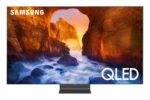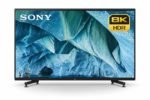Best TVs
If you are shopping for a new television the ideal time to get a deal is from black Friday through spring of the following year. Manufacturers release new year models around spring each year, so you can often find bargains as stores try to get rid of last year’s models before the new units arrive and obviously around Christmas time there can be some amazing sales as well.
We reviewed all the top TVs from 2019 to come up with our list of the best tvs in several different categories including:
Below you will find the best of the best from each category. Just click read more to find out more on each group.
If you need more information or purchasing advice see our TV Buying Guide.
Best LED HDTV

Samsung Q90 / Q90R QLED Series – Read More
Best OLED TV

LG C9 OLED Series – Read More
Best 4K TV

LG C9 OLED Series – Read More
Best 8K TV

Sony Z9G Master 8K – Read More
TV Buying Guide
Which new television to purchase is an important decision because of the price and how often you will be watching it. If you are confused read this guide and we will try to help you along.
Types – LED vs LCD vs QLED vs OLED vs 3D
The TV market is currently dominated by LED display technology, although newer OLED models are being manufactured. Although you see many TVs advertised as LED, these really are just LCD screens that use LEDs as their light source. Older LCD models used CCFL (cold cathode fluorescent lamp) technology as their light source.
QLED screens are a type of LED LCD screen that uses LED back-lights with quantum dots which are microscopic molecules that are contained on a film that when hit with the LED light, emit their own differently colored light. Although QLED picture quality can vary, the best QLED TVs usually have the second best picture quality to the OLED TVs.
OLED (Organic Light Emitting Diode) displays are a completely different type of technology which produce the best image possible. Instead of needing LEDs as a light source, an OLED screen has millions of individual OLED subpixels that emit light themselves to compose the image.
The main advantages of OLED TVs are brighter, better contrast and black levels, better uniformity, and wider viewing angle. However, they cost significantly more and only a few models exist. Many of these same qualities used to be found in plasma TVs which are no longer being made.
The main advantages of LED LCD screens are that they can be significantly cheaper and there are more options in screen size and models of TV available.
3D capable sets are not really a different type, but more of a feature of any version. However, currently none of the new models have 3D as a feature. There a few older televisions with 3D that you can find on sale, but they are rare. If you really want 3D capability you should consider a home theater projector.
Screen Size
When it comes to flat screen TV’s, bigger is better. The number one regret for buyers is that they did not go big enough, so we recommend getting the biggest you can afford and that will fit in the space where it will go. The most common sizes today are 55-inch and 65-inch (which is measured diagonally).
For a bedroom we consider the minimum size to be 32 inches, but could be much larger depending on space. For a small living room or TV room you should go with at least a 42-inch up to about a 55 inch version. For a larger living room where you might be sitting farther away from the unit or for a small theater room go with at least a 50 inch screen up to a 75 inch or as large as you can get. (For a dedicated home theater you might want to consider a projector)
Picture Quality
For most people the overall picture quality is the single most important attribute in buying a new television. The quality of any unit is a combination of many factors some of which include resolution, source content, refresh rate, contrast ratio / black levels, color accuracy, and screen uniformity. Buyers should be aware that many of the specs listed for any model are marketing gimmicks to make their brand appear better.
- Resolution – The resolution is the number of pixels a screen can display. Full HD is broadcast in 1080p, or 1920×1080 pixels which is also a 16:9 aspect ratio. In other words it displays 1920 pixels across the display horizontally and 1080 vertically. A 720p screen displays 1280×720 pixels, also a 16:9 aspect ratio.
Newer 4K or Ultra HD TVs have a resolution of 3840×2160 pixels which is 4x the resolution of full 1080p HD. The vast majority of TVs currently produced are 4K. These models can all upscale lower resolution content to 4K, however they vary in how well they do this.
Also 8K TVs are just now being developed and released as well. These models have a resolution of 7680 x 4320 pixels.
- Source Content – Today most content consumed is broadcast in HD, although more and more 4K content is being produced and will be the standard in the future. To truly get the best picture quality on a 4K TV you need 4K content, however like we said before they will upscale HD content to 4K.
If you are going to watch movies or shows on a disk then you need a 4K Bluray Player with 4K Bluray discs to get 4K content or a Bluray player and Bluray disks to get full high-def.
- Refresh Rate – Standard LCD televisions update the screen 60 times per second, or 60Hz. At that rate images with lots of motion like sports might blur, although OLED sets really do not have as much of an issue with motion blurring and do not need higher refresh rates. Many manufacturers now release models with 120Hz, 240Hz, or even higher like 600. The problem is the way they achieve those claims. Most use special processing tricks to achieve 600Hz and it is not a true 600Hz refresh rate. Ultimately only use the advertised refresh rate as a guide and not the deciding factor in whether a TV reduces motion blur.
- Contrast Ratio & Black Levels – Contrast ratio is the difference the between the brightest image a screen can display and darkest image, or black level. The problem with contrast ratio is there is no regulated way to measure it, so every manufacturer can define how they calculate it. Therefore, do not even look at contrast ratio when comparing models. Instead we feel that black levels, or the ability to produce a deep shade of black, have the most influence on the quality of the picture.
- Color Accuracy & Saturation – You want a screen that accurately matches the color and saturation of the source content or else you can get washed-out colors and orange-tinted skin tones. It is also important to get the image properly calibrated through the controls and settings provided on the TV.
- Screen Uniformity – Screen uniformity refers to how effectively the screen distributes its backlight. OLEDs usually have perfect uniformity, while a LED varies depending on how it is lit. Some LCDs use LEDs as their light source only along the edge (edge-lit) which can result in spots or patches where the backlight is visibly brighter. The top performing LED LCDs have ‘local dimming’ or ‘full array’ backlights that provide better uniformity due to more even spacing.
Features and Smart TVs
A smart TV generally refers to a model that has Wi-Fi for internet connectivity along with apps to view or download content and browse the internet. Many people use a streaming content device like Roku or their gaming console to access Netflix or Amazon Prime and find smart models redundant and unnecessary. However, most new models have Wi-Fi and some form of smart apps whether you want them or not.
Another important feature is connectivity. You need an HDMI cable to display 4K or HD content, so just count the number of devices you’ll want to connect and make sure the TV you want to buy has at least that many HDMI ports (Note: All HDMI cables are created virtually equal so do not waste your money on the most expensive ones). If you want to display photos you might want USB inputs and/or an SD card slot as well.



